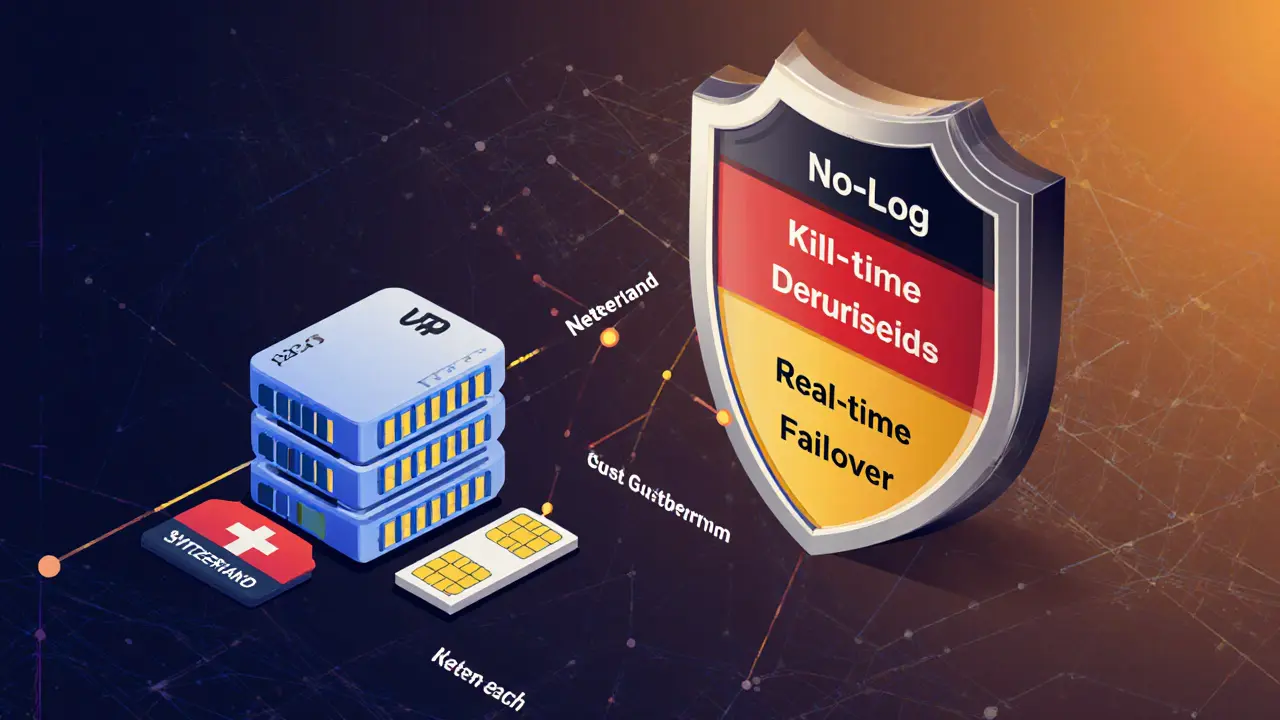VPN Risk Assessment Calculator
Your Current Setup
VPN usage for cryptocurrency trading in Iran is a work‑around that lets Iranian traders reach global exchanges while the local regime clamps down on digital money. The reality is harsh: every week a new blacklist shows up, and a dropped connection can instantly expose a trader’s real IP. This guide walks you through why people rely on VPNs, how exchanges sniff out hidden users, and what practical steps you can take to lower the chance of getting frozen.
Key Takeaways
- Free VPNs often leak IP data and lack strong encryption, making detection easy.
- Most exchanges now use device fingerprinting, transaction timing, and blockchain analytics to spot Iranian activity.
- When a VPN drops during a trade, the trader’s Iranian IP appears and accounts are usually suspended within minutes.
- Underground services bundle paid VPNs with foreign IBANs, OTP SIMs, and fake residency docs to bypass KYC.
- Future detection will likely combine network data with electricity‑usage monitoring, so no method is 100% safe.
Why Iranian Traders Turn to VPNs
Iran’s Central Bank bans domestic payments with crypto, yet the market still moves billions a year. Traders need a way to log into Binance, KuCoin, or other platforms that block Iranian IP ranges. A VPN encrypts traffic, masks the source IP, and makes it look like the user is surfing from Europe or North America.
In 2025, the underground ecosystem grew big enough to offer full identity‑circumvention packages. A typical bundle includes a paid VPN, a foreign IBAN for fiat withdrawals, a SIM card that receives OTP codes, and a forged passport‑style residency document. The package costs roughly $150-$250 per month, but it lets a trader move up to $50,000 a week without triggering basic geo‑blocking.
How Exchanges Detect VPN Users
It’s no longer enough to look at the IP address. Modern detection combines several signals:
- IP & geolocation checks - even if the VPN exits in Germany, the exchange may notice previous logins from Iran and flag the pattern.
- Device fingerprinting - browsers expose details like screen resolution, installed fonts, and canvas hashes. A German‑based VPN user with a Persian‑language OS raises a red flag.
- Transaction timing - most Iranian users trade during Tehran’s business hours (7am‑3pm). A sudden burst of activity from a German IP at those times is suspicious.
- Blockchain analytics - platforms like Chainalysis can trace wallet flows. The Nobitex‑TRON corridor, which handled $2billion in 2025, is now a known Iranian fingerprint.
- Withdrawal patterns - repeated withdrawals to the same foreign IBAN or to a handful of crypto‑friendly banks attract scrutiny.
When any of these signals cross a threshold, the exchange’s AML engine issues an automatic suspension. The trader receives an email saying “suspicious activity detected - account locked.”
Real‑World Enforcement Timeline
Winter 2024‑2025 saw a jump in crackdowns:
- Oct2024 - two blockchain intelligence firms launched a wallet‑identification bounty targeting Nobitex. Within weeks, dozens of Iranian wallets were flagged.
- Jan2025 - Iranian authorities froze over 1million bank accounts linked to crypto activity. The Central Bank announced tighter exchange‑control rules.
- Apr2025 - a massive drop in crypto inflows (‑11% YoY) coincided with a new VPN‑drop detection algorithm deployed by major exchanges.
- Jun‑Jul2025 - crypto inflows fell 50‑76% YoY as traders either fled the market or adopted the underground “identity package” route.
These events illustrate the cat‑and‑mouse game: each enforcement wave pushes users toward more sophisticated circumvention, which in turn forces exchanges to up their detection playbook.
Free vs. Paid vs. Underground VPN Solutions
Not all VPNs are created equal. Below is a quick side‑by‑side look at the three main options Iranian traders use.
| Feature | Free VPN | Paid VPN | Underground Service |
|---|---|---|---|
| Encryption strength | Often weak (AES‑128 or less) | Strong (AES‑256, OpenVPN, Wireguard) | Strong + custom tunneling |
| IP leak protection | Rarely includes kill‑switch | Kill‑switch, DNS leak guard | Multi‑hop routing, real‑time failover |
| Speed | Highly variable, overloaded servers | Consistent 100‑150Mbps | Optimized for trading latency |
| Support for OTP SIMs | None | None | Includes foreign SIM for SMS verification |
| Legal risk | Higher - logs sold to third parties | Lower - no‑log policies | Medium - operates in legal gray zone |
Most traders start with a free VPN, get caught, and then upgrade to a paid service. The most resilient users subscribe to an underground package that bundles everything they need to survive a KYC check.
Practical Tips to Reduce Detection Risk
- Never trade while a VPN is reconnecting. If you see a “Reconnecting…” banner, pause all orders until the tunnel is stable.
- Use a dedicated device. A separate phone or laptop that only runs the VPN and exchange apps limits fingerprint overlap with personal browsing.
- Randomize login times. Avoid the same 9‑am‑to‑11‑am window every day. Use a scheduler to vary activity by ±2hours.
- Mix exchange usage. Don’t funnel all trades through one platform; spread them across Binance, Kraken, and a decentralized exchange (DEX) to dilute pattern detection.
- Enable two‑factor authentication on a foreign SIM. If your OTP arrives on an Iranian number, the exchange can tie the code back to Iran.
- Clear browser caches and cookies after each session. Residual cookies can betray language settings or regional extensions.
- Consider multi‑hop VPNs. Routing through two or three exit nodes (e.g., Netherlands → Switzerland) adds layers of obfuscation.
These steps don’t make you invisible, but they raise the bar enough that an exchange’s automated system may let you continue trading while you work on a longer‑term solution.

Future Outlook: What’s Next for VPN‑Based Crypto Trading?
Two trends dominate the horizon:
- Integration of electricity‑usage data. The Ministry of Energy tracks power consumption of mining farms. If a cluster of high‑load rigs spikes in Tehran while a wallet withdraws large sums, authorities could correlate the two and flag the user.
- Expansion of bounty programs. International blockchain‑intelligence firms are now offering $10,000 per verified Iranian wallet linked to a sanctioned exchange. This will push more aggressive fingerprinting and faster blacklisting.
For traders, the takeaway is clear: rely on a single VPN trick won’t cut it forever. Diversify your privacy stack, keep up with enforcement news, and always have an exit strategy-whether that means moving funds to a privacy‑focused blockchain like Monero or holding a small amount in cold storage.
Bottom Line
VPN usage for crypto in Iran is a survival tool, not a silver bullet. Free services expose you, paid VPNs buy you time, and underground packages give you the full cloak but at a price. Understanding how exchanges detect you and acting on the practical tips above can keep your account alive for months, maybe even years, until the next crackdown.
Frequently Asked Questions
Can I use a free VPN safely for crypto trading?
Free VPNs usually lack strong encryption, kill‑switch, and no‑log policies. They often leak DNS requests, which lets exchanges see your real IP. In practice, they’re more likely to get you flagged than to protect you.
What is the biggest red flag for exchanges?
A VPN drop during an active transaction. The moment the tunnel breaks, the trader’s Iranian IP appears and the exchange auto‑suspends the account.
Do underground identity packages really work?
They work as long as the provider updates the foreign documents and SIM cards regularly. Many users have kept accounts alive for over a year using these bundles.
Is using a VPN illegal in Iran?
Iran’s law bans circumvention tools for financial services, but enforcement focuses on actual crypto transactions, not just VPN usage. Still, getting caught can lead to fines or account freezes.
Should I switch to a privacy‑focused blockchain?
Moving part of your portfolio to Monero or Zcash can reduce the data trail, but you’ll still need a VPN for exchanges that list those coins. It’s a complementary safety net, not a replacement.


Author
Ronan Caverly
I'm a blockchain analyst and market strategist bridging crypto and equities. I research protocols, decode tokenomics, and track exchange flows to spot risk and opportunity. I invest privately and advise fintech teams on go-to-market and compliance-aware growth. I also publish weekly insights to help retail and funds navigate digital asset cycles.